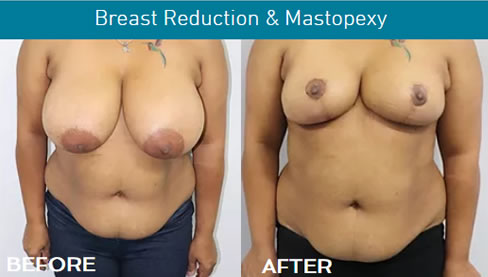If you feel your breasts are too large, for cosmetic or physical reasons, breast reduction surgery may be a beneficial option to consider. Many women find having the procedure gives them far more than just smaller, firmer breasts. They also report such benefits as relief from neck and back pain, a new freedom of movement allowing for more exercise and physical activity, and the ability to wear many clothing styles they’ve avoided in the past. In fact, of all cosmetic surgery procedures, breast reduction ranks among the highest in patient satisfaction.
Breast reduction (reduction mammoplasty) surgically removes excess skin and breast tissue, making your breasts more proportional to the rest of your body. During the procedure, the areola may be reduced in size and repositioned as well.
Frequently Asked Questions
Breast reduction offers benefits to women all ages, though waiting until breast development is complete is recommended. Since pregnancy and breast-feeding can affect your breast reduction results, many choose to postpone their surgery until they’ve stopped having children. If you do plan to breast-feed in the future, you should discuss this issue with Dr McHugh. Due to problems caused by overly large breasts, some women choose to undergo the procedure even if they plan future pregnancies.
Good candidates for breast reduction may have some of the following conditions:
– Body disproportion caused by breasts that are too large
– Chronic neck, back or shoulder pain caused by excessive breast weight
– Heavy, sagging breasts
– Deep shoulder indentations caused by pressure on bra straps
– Skin irritation beneath the breasts
– Restricted exercise and physical activity due to breast size
– Self-consciousness over large breast size
– Breast asymmetry with one breast larger than the other
A personal consultation with your surgeon is the first step for any patient considering breast reduction. Dr McHugh will assess your physical and emotional health, discuss your aesthetic goals, and address any questions or concerns you may have.
Issues you should be prepared to discuss during consultation with Dr McHugh include:
– Medical conditions, both past and present
– Current medications, including nutritional supplements and herbal remedies
– Previous surgeries
– Weight loss history and goals
During consultation, Dr McHugh will examine your breasts, evaluating their shape, size, skin elasticity and nipple position. He may also take photographs and measurements may for your medical record.
Some health plans cover breast reduction surgery when performed to relieve medical symptoms; however, coverage often depends on a significant amount of breast tissue being removed. In this instance you may also be entitled to a Medicare rebate.
There are many variations to breast reduction surgery. The technique Dr McHugh uses with you depends upon your individual features, physical needs and aesthetic goals.
The most common method, which offers the most significant level of reduction and lift, involves three incisions: One around the circumference of the areola, another running vertically from the areola to the breast crease and a third incision following the natural curve of the crease beneath the breast.
Through these incisions, Dr McHugh removes the excess breast skin and shapes the remaining breast tissue. The nipple and areola, which remain attached to the underlying tissue, are then shifted to a higher position. The areola can also be reduced in size for better proportion. You should understand that you may not be able to breast feed after breast reduction surgery, although in some cases it may be possible.
Depending upon the amount of reduction needed, the horizontal incision running along breast crease may be avoided in some cases. Though this modified technique is not appropriate for all women considering breast reduction, Dr McHugh does perform this option when appropriate.
Though thousands of women undergo breast reduction surgery each year and experience no major complications, the procedure does carry some degree of risk.
It is important you be well informed of these risks when considering breast reduction surgery.
The discussion of potential risks and complications is one of the most important aspects of patient consultation. During your consultation, Dr McHugh will discuss these potential complications with you, listen to your safety questions, and offer recommendations on how to minimise your risk.
It is important to follow Dr McHugh’s instructions when preparing for surgery to ensure the best possible results. Those instructions may include:
– Refraining from smoking for several weeks before and after surgery
– Avoiding certain medications
– Arranging for help following surgery, such as a ride home and in-home care for the first 24 hours
– Undergoing a baseline mammogram
For your comfort and convenience, Dr McHugh operates either in his clinic under local anaesthetic with intravenous sedation or under general anaesthetic at various private hospitals.
He will carefully monitor your physical status throughout the operation and during your recovery.
Directly after surgery, you’ll be taken to a recovery area. You will have a dressing over your breasts covered by a supportive bra. To aid healing and prevent fluid accumulation, small drain tubes may be placed beneath the skin.
On the day of surgery, you will be encouraged to get out of bed for short periods of time. The post-operative discomfort you feel during the first few days will be controlled with pain medication.
Though everyone heals at a different pace, the following is typical of recovery from breast reduction surgery:
Within the first week
– You will begin to move about more comfortably
– You may feel up to resuming some non-strenuous work
– Your dressings will be changed
– Any surgical drains used will be removed
– You should notice relief from back, neck and shoulder pain
After several weeks
– Swelling and bruising will diminish
– All stitches will have been removed
– Nipple sensation should gradually improve
– You may resume to most normal activities, including light exercise
After a few months
– Your breasts will start settling into a more natural shape
– Incision lines will begin to fade
Breast reduction surgery offers a high rate of patient satisfaction. Women often report better body proportion, more freedom to enjoy physical activities and joy at being able to wear clothing styles they’ve avoided in the past.
Though breast reduction surgery does entail permanent scarring, these scars can be easily concealed beneath clothing, swimsuits and tank tops and will fade significantly over time. Most women find the trade of scarring for their dramatic change in body proportion well worth it.
In most cases, your new breast size and shape should remain for several years to come. Factors such as weight fluctuation or subsequent pregnancies, however, can affect the longevity of the results. Over time, the effects of gravity may change the shape or your breasts. If this happens, you may choose to undergo breast lift procedure to help restore their more youthful contour.
Follow-up visits are important to answer any questions you may have and monitor your healing process. Your first post-operative visit will be scheduled after the initial healing period, during the first few days after surgery.
In the following months, Dr McHugh may ask you to return for periodic checkups. Keeping these appointments is important to assess your long-term results and address any questions or concerns you may have.
Breast Reduction Gallery

His dual specialisations enable him to deliver excellence in surgical results, with an eye for aesthetic beauty.
With over 20 years of experience as a surgeon in the private sector and performing international aid work as a Surgeon Commander with the Royal Australian Navy, you can have confidence that Dr McHugh is uniquely qualified and trusted to deliver the results you seek.








